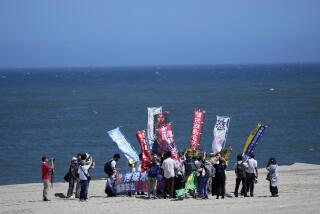Nuclear Power Worries Expand
- Share via
Thursday’s nuclear accident in Japan raises a number of questions about nuclear safety in that country as well as in the United States.
In the past few decades, major nuclear accidents have occurred at nuclear power plants such as Chernobyl and Three Mile Island. It is accidents at this type of facility that have been the focus of public concern. This accident, however, occurred at a fuel fabrication plant. At such a facility normally no nuclear reactions take place. Instead, uranium is chemically and physically converted into nuclear fuel, which is then shipped to a nuclear power plant for use.
On Thursday, however, workers mistakenly added too much uranium solution to a processing tank and a pulse of nuclear reactions took place. In the industry this is known as a criticality accident. This was not a nuclear explosion nor could an explosion have taken place since under these conditions the reaction is self-limiting. However, this accident led to a strong burst of radiation that seriously irradiated three workers and contaminated more than 20 others. Two of these workers seem certain to die within the next few days and others could perish over the next two months.
In a case like this one, the reaction is limited by the boiling of the water in the tank. Unfortunately, once the reaction stops, the water cools down and the reaction starts again. Apparently this start-and-stop process went on for at least 16 hours, which makes it the longest lived criticality accident ever to take place. The workers had been evacuated so there was no further exposure to them, but the additional heat and nuclear reactions have caused volatile fission products such as cesium and iodine to be released outside the plant. About 150 people living very near the plant had to be evacuated and 310,000 people in the city near the plant were told not to go outside.
That a criticality accident occurred in a modern fuel fabrication plant is a disturbing development. In the first few decades of the nuclear era, criticality accidents were fairly common. However, since the mid-1960s, such incidents have been extremely rare in Western countries. Concern about this problem has led much of the current generation of processing equipment to be designed so that its geometry and other measures prevent criticality from occurring.
The Japanese instead relied on the workers always carrying out the process correctly, something that was known to be dangerous long before this accident. In addition, there seems to have been no provision to prevent the fission products from escaping the plant, which puts the surrounding population at risk.
This accident is the latest in a series that have occurred in Japan. In 1995, there was a serious coolant leak at Japan’s prototype breeder reactor. It was ultimately determined to be the result of poor design and it was made much worse by the workers’ initial refusal to believe that anything serious was taking place. In other words, there were serious deficiencies in what in the industry is called the safety culture. It is likely that similar deficiencies will be found to be the cause of this accident as well.
Though criticality accidents at commercial nuclear fuel plants in the U.S. have been rare, this accident is bound to lead the public to ask if the same thing can happen here. This incident shows that nuclear safety is not just a problem at nuclear power plants. A lot more attention will now be focused on the safety of the six currently operating nuclear fabrication plants in the U.S. as well as other facilities in the nuclear industry.
More to Read
Sign up for Essential California
The most important California stories and recommendations in your inbox every morning.
You may occasionally receive promotional content from the Los Angeles Times.













